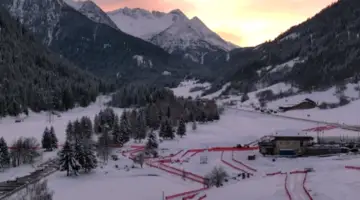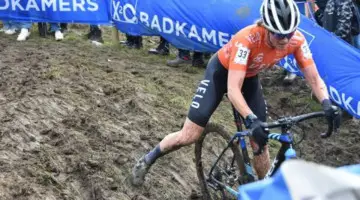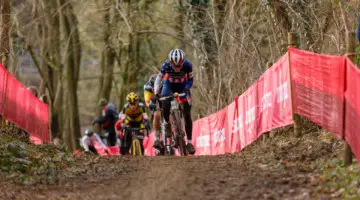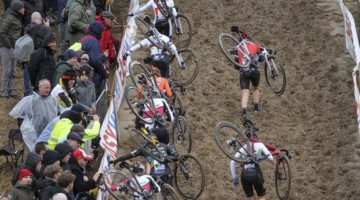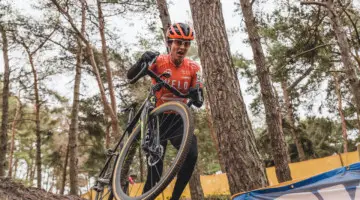Canada’s Siobhan Kelly is currently over here for a long block, sharing lodging at the ChainStay cycling house and Cyclocross Custom mechanics with me.
While she’s been here with Cycling Canada before, this, her second trip, is still eye-opening.
Siobhan and I have negotiated endless daily racing challenges together: finding the venue, parking, registration, bathrooms, etc. Professional event organization and consistent rules are valued in North America. Here tradition (we’ve always done it like this) trumps any sort of organization. We’ve also experienced the erratic application of the 80% rule.
As Siobhan puts it, “There is so much more to racing over here. There’s so much you don’t see on television, just the daily challenges and oddities that take getting used to.”
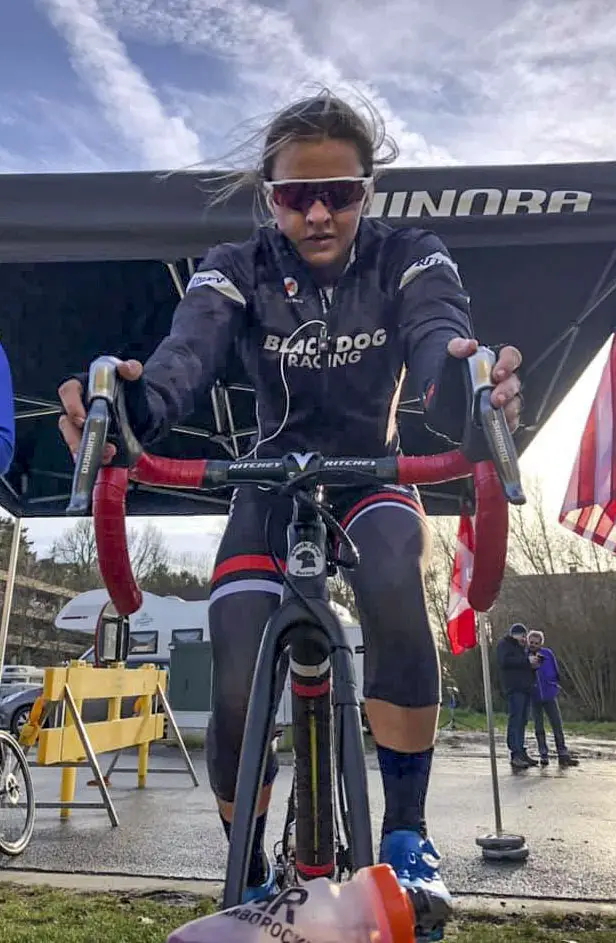
Siobhan Kelly is a privateer with Black Dog Racing. photo: Corey Coogan Cisek
Keeping up with the Van ders…
As a privateer rider with Black Dog Racing, Siobhan is used to do-it-yourself race day support with the help of her mom and dad. Here, she’s been blown over by Cyclocross Custom “doing everything for us.”
When it comes to bikes and our warm-up area, we need only think about tire pressures and asking for what we need.
Like Siobhan, I used to feel guilty receiving such assistance, including handing off my mud-laden kit, socks and shoes to mechanics for a wash.
Then I looked around.
We have support like none we have ever received in North America. Yet still, it’s difficult, nee impossible, to keep up with “the Joneses,” or in this case “The Van ders…”
At Zonhoven, we parked next to the fully-wrapped camper of a Junior woman. We watched as the junior opened the door of her camper, leaned out and repeatedly cried, “Mum, Mum” to summons her mom, lest she have to step out into the mushy grass.
Her call sounded like any teenager, anywhere, but she is a teenager whose parents have gone “all-in” on cyclocross. They have a camper with her name and image on the side and three sparkling, new-this-year, full Di2 bikes displayed outside.
Naturally, I am thrilled to see the increases in numbers and skills of the young female Dutch and Flemish riders. Equity is slowly coming to cyclocross in the Low Countries.
Parents of daughters now approach the sport similarly to parents of sons, providing their children with massive piles of equipment, spending their weekends as drivers, mechanics and soigneurs.
I was curious if these young riders had sponsorship support for all their bikes and wheels. From what I understand, they get “deals” on equipment, yet it’s the parents who invest their heart, soul and especially money into their child’s athletic development.
I fear the price tag for becoming the next Sanne is nearly as high as the price tag for becoming the next Wout.
Meanwhile, we (Siobhan, Japanese U23 rider Tetsuki Kaji and me) stayed warm in the ChainStay station wagon, which was stuffed to the gills with us, our gear and food. Watching the Dutch girl hanging out of her camper, we just laughed. When it comes to set-up, we can’t even keep up with the Juniors!
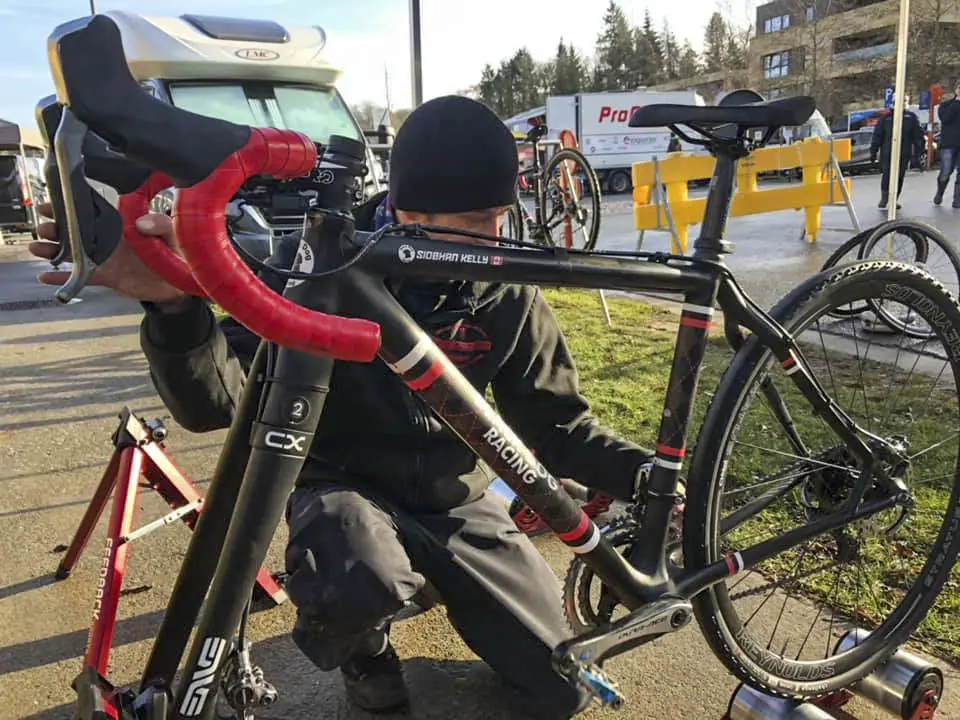
Cyclocross Custom helps take care of Coogan Cisek and a few other riders. photo: Corey Coogan Cisek
The Overijse Openbaar Toilet
The proliferation of camper vans is directly related to the absence of toilets available for athletes.
Honestly, it is getting better. The first year I was here, start-line porta-potties were all but absent. This year, every race has had at least one toilet at the start!
Likewise, one can always find a bank of porta-potties near the concessions. However, these are the choice of last resort. Getting to these toilets means fording mud and piles of beer cups. Then one leans one’s bike against the porta-potty, hoping against hope that a drunkard doesn’t walk off with it.
Overijse, the iconic muddy and hilly race famous for mud, roots and crashes is memorable for its lack of toilets. This year, the restroom challenges were next-level.
Typically, inschrijven (registration) is a reliable place to find a bathroom. Yet, this year, Overijse inschrijven was in a cafe whose windows and doors were plastered with signs indicating that the WC was available for 50 Euro cents for those not buying food.
I have my limits: I will not pay to use a bathroom at a race.
Thankfully, there’s always the Overijse “Openbaar Toilet. Openbaar is an important word to know, as it means “public.”
Overijse’s openbaar toilet is everything you might expect of public toilet: a single metal toilet/washbasin combo, lacking a toilet seat, soap or the modern convenience of hot water.
This year, for added challenge, Tim Merlier’s camper and entourage were parked directly in front of the openbaar toilet. In order to access the facilities, one had to casually duck under his barrier tape and squeeze behind a camper.
Forgive me for devoting a couple hundred words to discussing toilets. They symbolize what it’s like to race here.
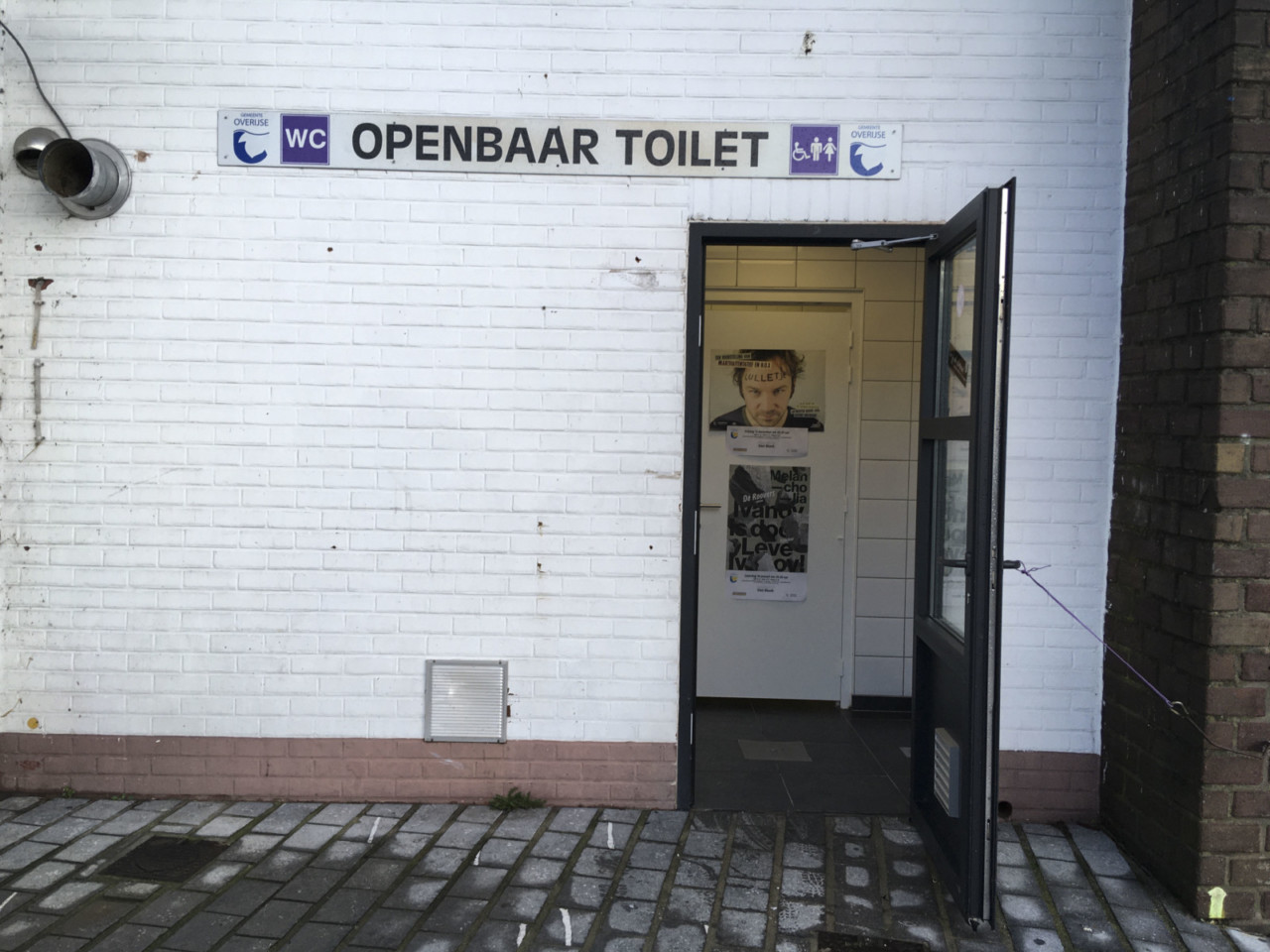
The vaunted Openbaar Toilet. photo: Corey Coogan Cisek
Races sometimes feel a bit inhospitable.
We North Americans definitely feel “foreign” standing on a towel, wrapped in a jacket, changing carside. This is one of the many things we North Americans do, which Belgians would never do, because they don’t need to. They have campers.
The first year I came here I was afraid of my own shadow.
It terrified me when I could not communicate effectively with the parking guards. I was taken aback when commissaries became gruff if I asked for an extra parking pass for my mechanics. Nowadays, none of that bothers me.
In fact, I find the whole thing a bit comical. What next?!
I’ve adapted a sense of humor and an act first, apologize later mindset.
In Overijse, the kleedkamers (post-race showers) were clear over the hill on the backside of the course. I happened upon an open art gallery and washed mud out of my crash wound in their restroom sink. This entertained onlookers and they asked where I was from.
“America,” I said, and they nodded, as if that explained it all.
80% Rule Applied by Instinct, Rather Than Stopwatch
I’ve been known to boast when I make lead lap, finishing on the same lap as the leaders. Still, I’m going on record: the 80% pull rule is fickle in Belgium.
At European World Cups, commissaires usually get it right. I mean, when in World Cups do you see riders being lapped (save the occasional incident caused by a rider’s major mechanical causing a single very slow lap)?
However, in non-World Cups this side of the pond, riders sometimes get lapped.
Typically, I can tell whether I am going to finish lead lap. In fact, often I can tell before the race. The formula is simple: if there are many starters (bottlenecks on the first lap) and the course is short (riders do more laps), I am at risk of getting pulled.
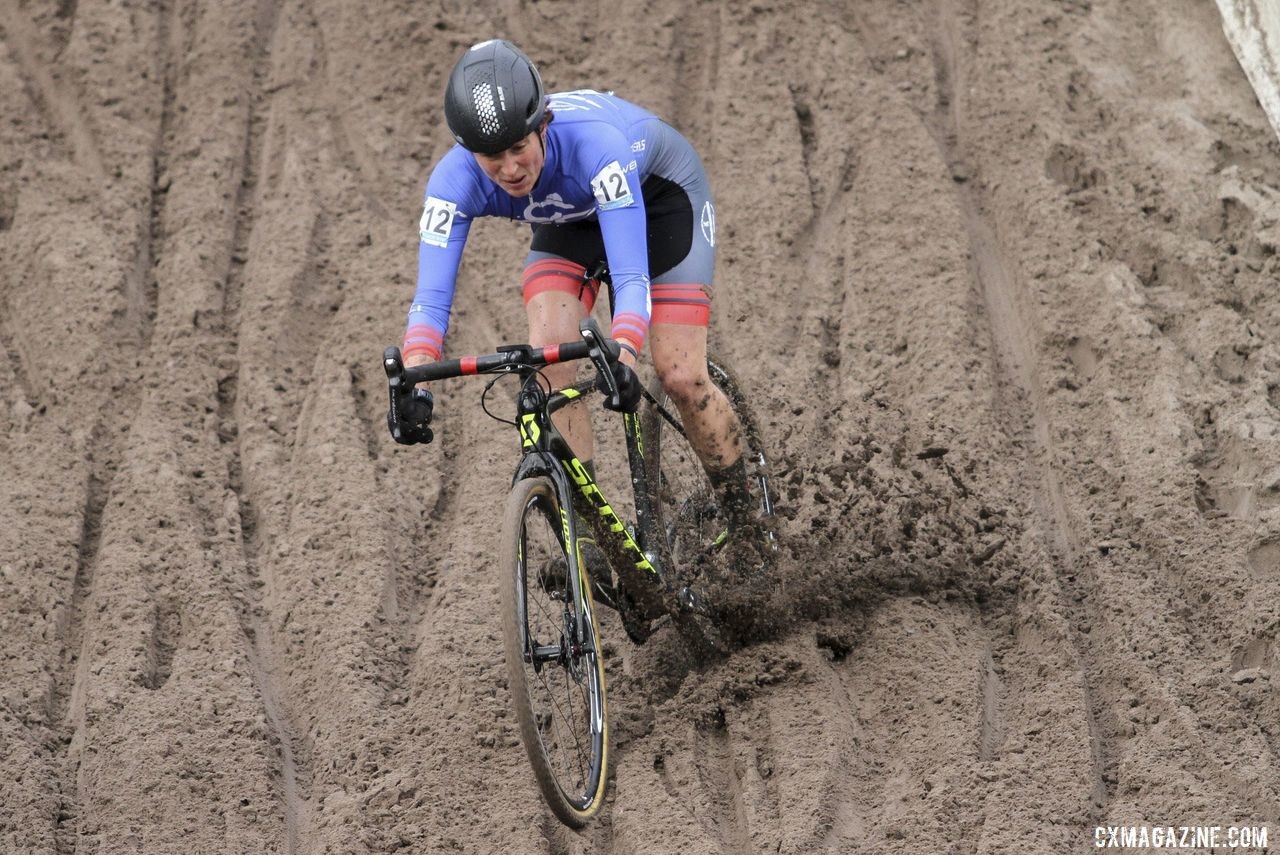
Corey Coogan Cisek drops into De Kuil. 2019 Superprestige Zonhoven. © B. Hazen / Cyclocross Magazine
There was a regrettable incident at Zonhoven. I was among a pack of riders lapped by the leaders.
Embarrassing yes, but moreover frustrating. The last thing any of us want is to negatively impact the race. When you’re in the hurt box, you are hardly in the position to watch your back for the leaders.
The commissaires should have seen it coming.
It rained before Zonhoven, making usually barely rideable sand, concrete fast. As a result, women were given six laps, a high number.
Competition for the Women’s SuperPrestige title is currently fierce with many contenders. The Women’s and Men’s SuperPrestige overall prize purses were equalized this year for the first time ever. Women are racing for large sums of cash.
The race in Essen, the day before, was poorly attended. Thus, many of the top riders came into Zonhoven fresh. All of these things put together meant the race would be competitive and fast.
Additionally, there was still a pack of riders together going into the final lap. The podium would need to throw down a fast final lap.
Since I made it onto Lap 5, naturally, I thought I would complete that lap without the leaders passing. I became a little concerned when I heard the leaders dropping into De Kuil (the sandpit) just as my pack exited the other side. Still, I thought we would make it around the lap.
You would think you would hear the roar of the crowd paralleling the leaders, but this is Belgium.
While De Kuil was a drunken roar, on the outer reaches of the course, it was quite silent. (The respectful Flemish and Dutch tend to only shout for their favorite riders.)
I was within a group of four fighting for position. Running the last run-up, I heard someone on my shoulder, but I thought it was a rider from my group.
In fact, it was leader Ceylin del Carmen Alvarado behind me, and she shrieked. The lead pack was mixing with our pack. I scurried toward the far side of the course. Others in my group also caught on and tried to get out of the way.
The situation was quickly sorted and my group hopped into the gap behind them. When we got to the 80% line, I expected to be whistled off, but nothing, nada…
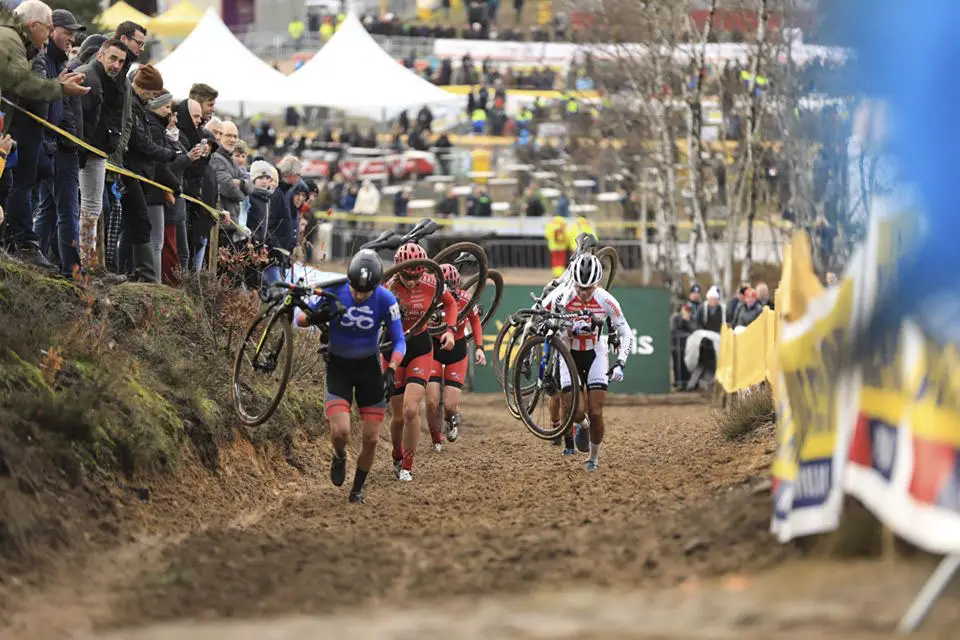
Coogan Cisek ended up racing with the leaders at Zonhoven, at least temporarily. © Luc Wilms
The officials stood there staring.
Being the wife of a USA Cycling official, I dutifully waved at them, signaled and pulled myself. This woke them up, and they began waving frantically, yet at least one of our group still crossed the finish among the leaders.
To be clear, this day was an anomaly. The group of us caught are “usual finishers,” women I recognize from World Cups. For context, only 26 riders finished lead lap, which is an uncommonly small number.
Yet, still, it’s math, right?!
How hard is it to track who falls out of 80%?
It’s different over here.
In the U.S., officials painstakingly record lap times and numbers. While there’s a bit of discretion and educated guess, 80% is usually applied accurately. Our officials must be more willing to err on the side of pulling, as I cannot think of a time when a group was lapped in a North American UCI race.
In Belgium, 80% seems to be applied more by discretion, or feel, or television pressures, or convenience (when there happens to be a large gap).
There is always television to consider.
In Belgium, the men always usually start at 15:00. The Elite Dames usually at 13:45 or 13:40. It’s all based on television, including the football (soccer) schedule. It’s not unusual for women to start at one time on a Saturday and the other on Sunday.
Are we more likely to be pulled on the 13:45 start days, so that we are off the course for men’s staging and pre-race interviews? Then again, rules are not followed so closely here.
You know how in North America, the expectation (the rule) is that when making a bike exchange, you won’t be long without a bike? Maybe you take a step or two between bikes. In Belgium, it’s not unusual to run a fair distance between bikes. On a muddy course when we run through the pit, it feels divine to run a ways without the bike.
Here commissaires apply the rule with the warning, “Just don’t push it too far.” Running the equivalent distance of one and one half pit boxes between bikes is not at all uncommon here. Given this, it’s perhaps no surprise that 80% isn’t viewed as a hard and fast mathematical equation.
Next up Kersteperiode. What’s Failure? What’s Success?
Kersteperiode is just around the corner and many North Americans are headed over here to try their hand at racing in the mud. Related to the lead lap discussion above, I challenge you to view your favorite North American riders’ performances through a different lens.
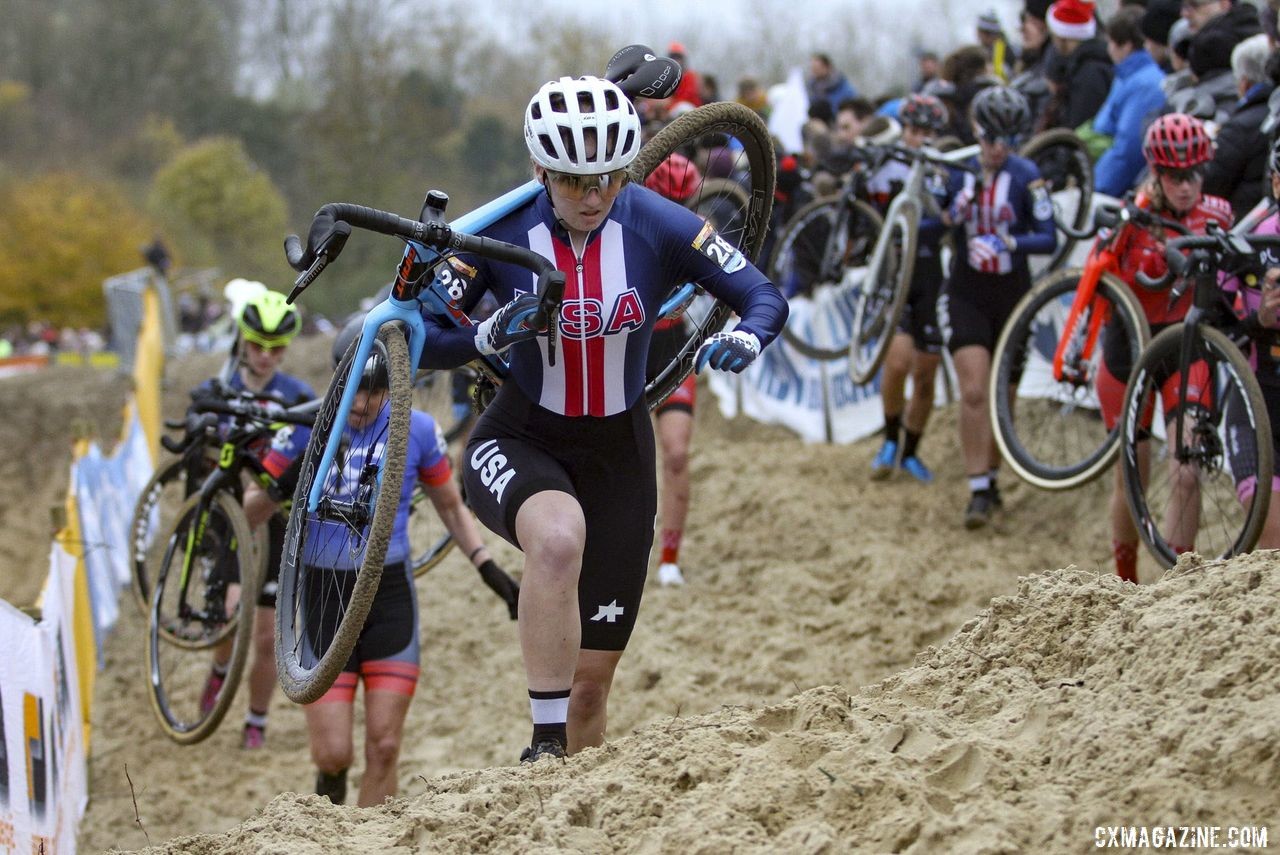
Corey Coogan Cisek and many young U.S. riders will be taking on Kerstperiode this week. 2019 World Cup Koksijde. © B. Hazen / Cyclocross Magazine
It’s easy to “count-back” the number of riders behind the rider and evaluate success this way.
Don’t. This isn’t North America. There are not many development racers in the field. The Belgians have to qualify at their National Championships to even start Belgian UCI races. The top-20, and then some, are full-time professionals paid to start, and as above, driving their campers with 3 to 5 bikes and countless wheelsets, sleeping in their own beds, having Christmas with their families.
I challenge you to count from the front, look at time back, and look for progression over their trip. This is a hard place. It doesn’t play by the same “rules” as North America.
Bravo to the development riders and Juniors sticking their neck out and giving it a try … coming over here to fight through the mud. I too will be doing the same, even if I am at a much different place in my cycling career.























